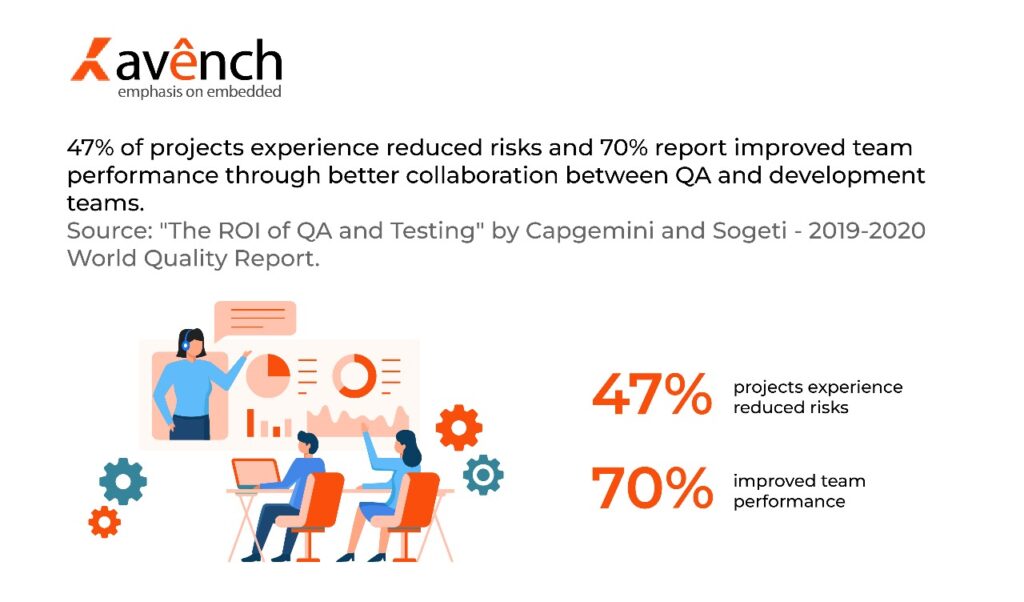Software testing has become essential in building reliable and efficient systems. However, while methods such as manual testing, automation, and regression are commonly discussed, embedded quality assurance (QA) often receives less attention. Embedded QA integrates quality checks throughout the software development lifecycle, ensuring that quality is a priority from the beginning and continues throughout the development process. This approach is especially critical in embedded systems and embedded software, where precision and reliability cannot be compromised.
Embedding Quality Assurance: Building Quality from the Start
Incorporating quality checks early in development, also known as “shifting left,” allows teams to identify potential issues before they snowball into costly and time-consuming problems. With embedded quality assurance, testing isn’t a separate phase after development but happens simultaneously with coding. By catching errors early, teams can optimize resources and reduce the need for rework later in the process.
This early integration is particularly valuable for embedded software quality assurance, where both real-time performance and stability are essential. Embedded systems, unlike general-purpose software, often interact directly with hardware and have strict requirements. By building quality from the start, organizations can significantly reduce risks, lower costs, and ensure their systems are robust.
Benefits of Early Integration
Reduced risk: Testing early in the cycle minimizes the chance of significant defects appearing during the later stages of development.
Lower costs: Fixing issues early is far less expensive than addressing them once the system has been fully developed.
Collaboration: Developers and testers work together more closely, leading to better communication and quicker resolution of issues.
The Role of Automation in Embedded QA
Automation plays a pivotal role in testing within an embedded QA framework. Automated tests are developed in parallel with the code, enabling immediate identification of bugs. This real-time feedback ensures that teams can address issues as they arise, preventing the accumulation of technical debt that could otherwise slow down development.
In the context of quality assurance in embedded systems, automation helps reduce the burden of repetitive manual testing. It also ensures that all aspects of the system are tested rigorously, which is essential given that embedded systems often function under strict operational constraints. The use of continuous integration (CI) and continuous deployment (CD) further enhances efficiency, allowing each software release to be thoroughly tested before deployment.
Why Automation Matters
- Faster bug detection: Automated tests are executed in real time, meaning issues are caught as soon as they occur.
- Efficiency: Automation reduces manual testing time, allowing QA teams to work on improving the overall test strategy.
- Reliability: Automated regression tests ensure that new updates do not break existing functionality.
Breaking Down Silos: A Collaborative Approach
A common problem in software development is the separation between development and QA teams. In many cases, this separation creates communication gaps, delays, and misaligned goals, making it more challenging to fix bugs and improve software quality. Embedded QA encourages close collaboration between developers and QA teams, breaking down these silos and creating a more integrated approach.
By working together, developers and testers can share knowledge and ensure the software meets both functional and performance requirements. This is particularly important for embedded software quality assurance, where the interaction between software and hardware requires specialized understanding.
Collaborative Benefits
– Faster feedback loops: With teams working together, issues can be identified and addressed more quickly.
– Better understanding: Developers gain a better understanding of QA concerns, while testers become more familiar with development challenges.
– Shared responsibility: Everyone on the team has a vested interest in the quality of the software, creating a more cohesive effort.

Shift-Left Testing: Identifying Issues Early
Shift-left testing is one of the core principles in embedded QA. It involves moving testing activities earlier in the development cycle to identify and prevent issues before they occur. By testing as code is written, this method minimizes integration problems, performance issues, and security vulnerabilities, all of which can be particularly challenging in embedded systems.
This proactive approach helps prevent costly defects and ensures smoother performance. Quality assurance in embedded systems becomes more effective by addressing issues during the design and development stages, reducing the chances of encountering major problems later on.
Key Advantages of Shift-Left Testing
– Prevention over cure: Fixing defects during the design and development phase reduces the likelihood of encountering major issues later.
– Continuous testing: Regular testing during each phase of development provides more opportunities to identify and resolve problems.
– Cost efficiency: Early identification of defects reduces the amount of time and resources needed for corrections later on.
Real-Time Feedback: Ensuring Continuous Improvement
One of the primary benefits of embedded QA is the real-time feedback loop it creates between developers and testers. Immediate feedback helps resolve issues as they arise, improving both the speed and quality of development. This constant flow of information reduces delays and ensures that developers do not need to wait for bug reports before fixing problems.
In embedded software quality assurance, real-time feedback is especially critical. Embedded systems must operate with precision and stability, and any performance issues must be identified and addressed immediately. By fostering a continuous feedback loop, embedded QA helps maintain high standards of quality throughout the development process.
Managing Technical Debt: Preventing Future Problems
One of the primary benefits of embedded QA is the real-time feedback loop it creates between developers and testers. Immediate feedback helps resolve issues as they arise, improving both the speed and quality of development. This constant flow of information reduces delays and ensures that developers do not need to wait for bug reports before fixing problems.
In embedded software quality assurance, real-time feedback is especially critical. Embedded systems must operate with precision and stability, and any performance issues must be identified and addressed immediately. By fostering a continuous feedback loop, embedded QA helps maintain high standards of quality throughout the development process.

Benefits of Managing Technical Debt
- Reduced maintenance costs: Fewer bugs and fewer quick fixes lead to lower long-term maintenance expenses.
- Stable software: Continuous attention to quality ensures the software remains reliable as it evolves.
- Longer product lifespan: Software that is built to last requires less rework and fewer overhauls, increasing its usability.
Final Thoughts,
Embedded quality assurance plays a fundamental role in ensuring that embedded systems and software function smoothly. By integrating quality checks early in the development process, fostering collaboration between teams, and leveraging automation, companies can build more reliable, stable, and scalable systems.
For more information on embedded product design companies in usa subscribe to our blog. For sales queries, contact us at +1 (775) 404-5757 or email sales@avench.com. We are here to assist you.

